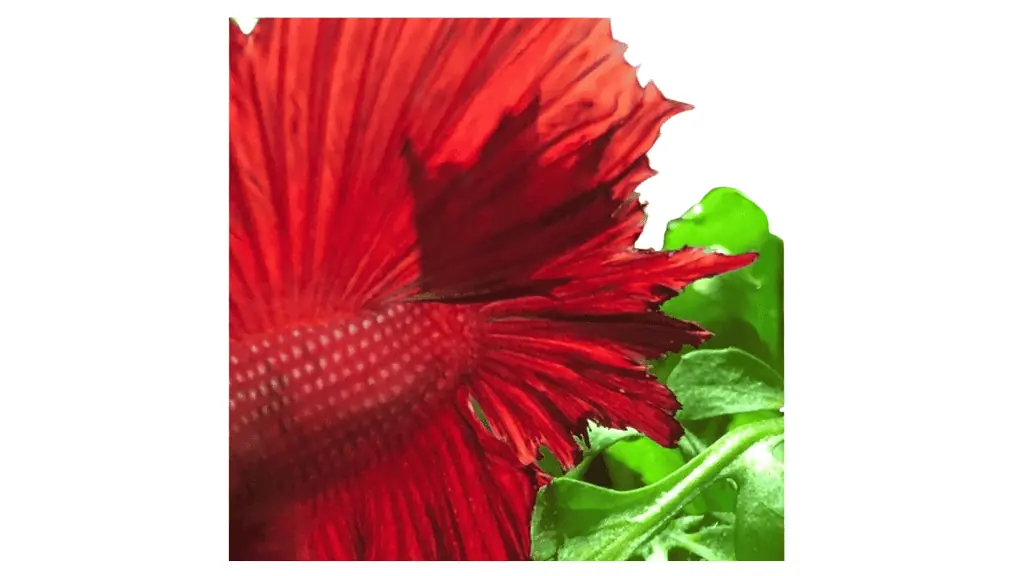Betta fish, known for their vibrant colors and flowing fins, are a favorite among aquarium enthusiasts.
Yet, many betta fish owners encounter the common issue of fin loss. The key question is: do betta fish fins grow back?
Betta fish fins grow back, but the extent of regrowth depends on the cause and severity of the fin loss and the treatment and care provided to the fish. Common causes include fin rot, fin biting from other fish, and injury from decorations and objects in the tank.
With the right knowledge and care, you’ll be able to help your betta fish overcome fin loss and thrive in its aquatic home.

Table of Contents
What Causes Betta Fish Fin Loss?
Fin Rot
Fin rot, a bacterial or fungal infection, causes your betta fish’s fins to decay and fall off.
This can be distressing for both the fish and the fishkeeper. So, what are the symptoms of fin rot?
Look for discolored, ragged, or frayed fins, red or black edges, and white or fuzzy patches. Your betta fish might also show signs of lethargy and loss of appetite.
Poor water quality, stress, overcrowding, and overfeeding are common fin rot causes.
As a dedicated fishkeeper, paying close attention to your betta fish’s living conditions is essential.
Fin Biting
Fin biting, a behavioral issue, leads to betta fish biting and tearing off their betta fins.
This can be both concerning and perplexing. Symptoms of fin biting include uneven or jagged fins, missing chunks of fins, and stress stripes.
Boredom, stress, frustration, and loneliness are potential reasons for your betta fish to engage in fin biting. Monitor your fish’s environment and mental well-being to prevent this behavior.
Physical Damage
Finally, physical damage refers to injuries causing the fins to break or tear.
Torn or ripped fins, bleeding, and swelling are all symptoms of physical damage.
Typically, this results from sharp objects in the tank, like rough decorations, aggressive tank mates, or rough handling.
To protect your betta fish, ensure its environment is hazard-free and always carefully handle the fish.
Understanding and addressing the causes of fin loss can help your betta fish live a happy, healthy life.
Treatment Options for Betta Fish Fin Regrowth
Addressing betta fish fin loss promptly is crucial to prevent further damage and ensure the health of your aquarium fish.
Here are the primary steps and treatment options for betta fish fin loss.
1. Improve Water Quality
The most common treatment for fin damage and regrowth involves improving water quality through frequent water changes, testing water parameters, and using a filter and heater.
Ideal Water Parameters for a Betta Fish Tank Include the following:
- Temperature: 78-80° degrees Fahrenheit (25.5-27° C)
- pH: 6.5-7.5
- Ammonia and Nitrite: 0 ppm
- Nitrate: < 40 ppm
- gH: 3-4 dGH (50-66.7 ppm)
- kH: 3-5 dKH (53.6-89.4 ppm)
- Minimum Tank Size: 5 Gallons
A dirty tank will only worsen the problem and turn damaged fins into bacterial infections.
Consider moving your betta to its own quarantine tank for a safe environment.
2. Aquarium Salt, Indian Almond Leaves, or Antibiotics
Another treatment option involves using aquarium salt, Indian almond leaves, antibiotics, or other aquarium medications.
Aquarium salt can help prevent infection and promote healing by creating a hypertonic environment. However, it shouldn’t be used for more than 10 days or with live plants.
3. Nutritious and Varied Diet
Offer your betta fish a nutritious and varied diet, such as:
- High-protein pellets
- Flakes
- Frozen or live foods
- Vitamins
Feeding your betta fish twice daily and avoiding overfeeding can also contribute to fin growth.
4. Reduce Stress and Boredom
Alleviating stress and boredom for your Siamese Fighting Fifish can be achieved by adding plants, hiding places, toys, and mirrors to the tank.
Preventing overcrowding, overstimulation, or aggressive fish and other tank mates can also support fin growth.
5. Trim Necrotic Tissue
Carefully trim the necrotic tissue on the fins using sterilized scissors or tweezers.
This can help prevent further infection and decay of the fins. However, this should be done cautiously and only if the betta fish cooperates.
Other Treatment Options
For fin rot, consider using methylene blue, a dye with antifungal and antibacterial properties. It can be added directly to the tank water or used as a dip.
However, methylene blue can stain the tank and equipment and harm beneficial bacteria.
Another option for fin rot is kanaplex, a medication containing kanamycin, a broad-spectrum antibiotic. Kanaplex can be added to the aquarium water or mixed with food.
However, it can be toxic to some fish and invertebrates and may affect the nitrogen cycle.
Vitamin B for Fin Regeneration & Adding It To Your Betta’s Diet

The Importance of Vitamin B
Vitamin B plays a key role in fin regeneration and maintains your betta fish’s overall health.
It assists with cell growth and repair, making it an indispensable element in healing.
Natural Sources of Vitamin B
To provide your betta fish with vitamin B, consider these natural food sources:
- Daphnia
- Bloodworms
- Brine shrimp
Supplements and Products
Additionally, introduce vitamin B to your betta’s fresh water or food using supplements or products like Vita-Chem or Stress Coat.
Feeding Recommendations
As a rule of thumb, feed your betta fish a varied diet which includes vitamin B-rich foods 2-3 times per week.
Follow the product label instructions for specific dosages when using supplements.
Aloe Vera Gel or Indian Almond Leaves To Promote Healing
Healing Properties
Aloe vera gel and Indian almond leaves can aid in healing and prevent infection in your betta’s fins.
Both contain properties contributing to the healing process, such as:
- Anti-inflammatory
- Antibacterial
- Antifungal
- Soothing
Precautions and Side Effects
While aloe vera gel and Indian almond leaves are generally safe, be aware of some precautions and potential side effects:
- Possible allergic reactions
- Water discoloration
- pH changes
Usage Instructions
For aloe vera gel:
- Mix a small amount of aloe vera gel (approximately 1/4 teaspoon) with dechlorinated water.
- Add the mixture to your betta’s tank.
- Repeat every few days until the fins show signs of improvement.
For Indian almond leaves:
- Add one small Indian almond leaf per 5 gallons of tank water.
- Replace the leaf every 2-3 weeks or when it starts to disintegrate.
- Monitor water parameters, and adjust as needed to maintain appropriate pH levels.
Incorporating vitamin B into your betta fish’s diet and using aloe vera gel or Indian almond leaves will promote healing and support fin regrowth for a healthier, happier betta.
How Long Does It Take for Betta Fish Fins to Grow Back?
The timeline for betta fish fin regrowth varies widely, influenced by factors like the extent of fin loss, the treatment approach, water quality, diet, and the fish’s stress levels.
Fins may begin to regrow in just a few weeks, but in some instances, the process could take several months.
Many betta fish owners have reported seeing improvements in just days or weeks.
However, it’s essential to recognize how some fins might not fully regrow, or they could exhibit different colors and textures than before.
Refer to the table below for a helpful overview of fin regrowth time frames under diverse conditions:
| Condition | Time Frame | Real Examples |
|---|---|---|
| Fin Rot | A few weeks to several months | Reddit User (unknown) |
| Fin Biting | A few days to several weeks | Reddit User u/xesgr |
| Physical Damage | A few days to several weeks | Reddit User u/ashleyasinwilliams |

Fin Rot

Fin Biting

Physical Damage
Tips to Speed Up the Recovery Process:
- Keep the water clean and warm (78-80° degrees Fahrenheit or 25.5-27° C)
- Feed a high-quality diet with occasional treats (such as bloodworms or brine shrimp)
- Avoid overmedicating or overdosing the fish
- Observe for any signs of improvement or worsening
- Provide enrichment and stimulation for the fish (such as plants, toys, mirrors, etc.)
- Reduce stress factors (such as bright lights, loud noises, etc.)
- Consider adding a companion or changing tank size if appropriate
- Use stress coat or aloe vera gel to help heal the wounds
- Remove any sharp or harmful objects from the tank; use plastic plants
- Separate any aggressive tank mates or move them to a larger tank if possible
Adhering to these guidelines and attentive care can aid your betta fish’s fin regrowth and contribute to their overall well-being.
How to Prevent Betta Fish Fin Loss?

Preventing fin loss in betta fish primarily involves avoiding common causes of fin damage, such as fin rot, biting, tearing, or nipping.
Here are some strategies to help dodge these issues:
Fin Rot Prevention:
- Maintain clean water free of ammonia, nitrite, and nitrate.
- Utilize a filter and heater to ensure stable water quality.
- Regularly test water parameters and perform water changes as needed.
- Treat any signs of infection with aquarium salt, Indian almond leaves, or aquarium antibiotics.
Fin Biting Prevention:
- Minimize stress and boredom by offering plants, hiding spots, toys, and mirrors.
- Prevent overstimulation or reflection with dim lighting or by covering the tank at night.
- Observe your betta’s behavior and adjust the tank environment accordingly.
Fin Tearing or Nipping Prevention:
- Opt for silk or live plants instead of plastic ones.
- Sand and file down any sharp edges or decorations in the tank.
- Refrain from housing other fish or animals nipping at your betta’s fins.
- Ensure adequate space and territory for your betta fish.
An essential aspect of preventing fin loss is fostering fin growth by offering your betta fish a nutritious and diverse diet.
Include high-protein pellets, flakes, frozen or live foods, and vitamins to ensure their fins grow strong and healthy.
Stick to a feeding schedule twice daily, but be mindful not to overfeed, as this can hinder fin growth.
Furthermore, stay attentive and proactive regarding your betta’s health and well-being. Routinely examine their fins for any indications of damage or infection.
Keep track of their progress by snapping photos or taking measurements of their fins.
If you ever find yourself uncertain about any aspect of their care, don’t hesitate to consult with fellow betta enthusiasts or professionals.
Frequently Asked Questions about Betta Fish Fin Regrowth
How can I tell if my betta fish fins are growing back?
The primary indicator of fin growth is the emergence of clear or transparent edges on the damaged fins, signifying new tissue formation. These ragged edges may eventually return to their original color or adopt a slightly different hue.
Another sign of fin growth is an increase in the length or width of the fins, which can be compared to previous photos or measurements. However, depending on the extent of the damage, some fins may not grow back to their original size or shape.
Fin rot can be identified by black or brown edges on the fins, indicating necrotic tissue needing to be trimmed. Fin rot may also cause the fins to appear ragged, melted, or curled.
What if my betta fish fins don’t grow back?
In some instances, fin loss may be permanent due to genetic factors, chronic infections, or severe damage. Nevertheless, this doesn’t mean your betta fish can’t lead a happy and healthy life.
Prioritize maintaining optimal water quality, supplying a well-balanced diet, and fostering a stress-free environment for your betta fish.
These factors significantly contribute to their overall well-being, regardless of whether their fins fully regenerate or not.
Damaged Betta Fins aren’t A Lost Cause
Betta fish fins can grow back with proper treatment, care, and effective prevention measures.
By understanding the causes of fin loss and applying the appropriate treatment and care methods, you help your betta fish recover and enjoy their vibrant, colorful fins.
With proper care, healthy and happy betta fish can thrive in your aquarium for up to five years, providing you with a lively aquatic companion.
Thank you for reading this article on betta fish fin regrowth. We hope you found it informative and helpful.
Check out our other post on the best toys for betta fish to see what is safe for your tank.


